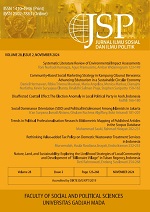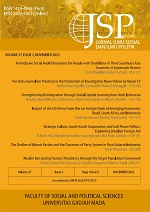A Participatory Culture for Developing an Inclusive Environment in Higher Education
Dhyah Ayu R. Widyastuti(1*), B.K. Prihandono(2), A.B. Pramudyanto(3), L.A. Rudwiarti(4)
(1) Department of Communication Science, Universitas Atma Jaya Yogyakarta, Indonesia
(2) Department of Sociology, Universitas Atma Jaya Yogyakarta, Indonesia
(3) Department of Communication Science, Universitas Atma Jaya Yogyakarta, Indonesia
(4) Department of Architecture, Universitas Atma Jaya Yogyakarta, Indonesia
(*) Corresponding Author
Abstract
Increasing understanding, concern, partiality, and equality for persons with disabilities is important. One disparity can be found in the educational area. The role of the government to increase the capability of this group is the enactment of Law No. 8 of 2016, which substantially provides accessibility to persons with disabilities. The education environment needs to participate in building a disability-friendly education climate. This paper presents a higher education case study for students with special needs at Universitas Atma Jaya Yogyakarta. The research uses the Inclusive Participatory Action Research approach to explore problems, design program planning, management, and implementation of efforts to create a disability-friendly environment. Through this approach, persons with disabilities are the subject of planning, implementation, and evaluation. It means that the active involvement of the target group is essential in this effort. The results show that participatory culture is essential in building an inclusive environment in higher education. The commitment and cooperation of all university members can realize a disability- friendly environment. The focus of this article includes (a) efforts to build a disability-friendly environment; (b) disability-friendly education approach; (c) challenges in the implementation and environmental impacts of inclusion in higher education. Hopefully, this idea can contribute to building an inclusive environment in an educational institution.
Keywords
Full Text:
PDFReferences
Anjani, A. (2021). 5 Universitas Swasta Terbaik di DI Yogyakarta versi Kemendikbud 2020. (5 Best Private Universities in DI Yogyakarta version of the Ministry of Education and Culture 2020). https://www.detik.com/ edu/perguruan-tinggi/d-5655051/5- univ ersitas-sw asta-terbaik-di-di- yogyakarta-versi-kemendikbud-2020.
Arini, F. D. (2020). How Accessible the University Websites in Indonesia for People with Disabilities. Indonesian. Journal of Disability Studies (IJDS), 7(2), 164–169.
Ashari, M. (2020). Data: 58 Perguruan Tinggi di Indonesia Ubah Metode Belajar, Jumlah Bisa Bertambah. www.pikiranrakyat.com/ pendidikan/amp/pr--01351622/data-58 perguruan-tinggi-diindonesia-ubah- metode-belajar-jumlahbisa-bertambah
Burgstahler, S. E. (2008). Universal Design of Instruction: From Principles to Practice. In S. E. Burgstahler & R. C. Cory (Eds.), Universal Design in Higher Education: From Principles to Practice (pp. 23–43). Harvard University Press.
Cameron, L., & Suarez, D. C. (2017). Disability in Indonesia: What Can We Learn From The Data. Monash University.
Deleuze, G., & G. F. (1987). A thousand plateaus: Capitalism and schizophrenia (Brian Massumi, Trans). University of Minnesota Press.
Disability Friendly Colleges. (1998). New Mobility.
Ediyanto, Aris Setiawan, Irvan Budi Handaka, Nurul Hiday at i Rofiah, S. (2021). Implementation of Inclusive Education in Learning Process at Senior High School Malang City, Indonesia. Indonesian Journal of Disability Studies, 8(1), 179–189.
Evans, N. J., & Broido, E. M. (2011). Social Involvement and Identity Involvement of Students with Disabilities. Poster presented at the Association for the Study of Higher Education conference, Charlotte, NC.
Fernandez, S. (2021). Making space in higher education: disability, digital technology, and the inclusive prospect of digital collaborative making. International Journal of Inclusive Education, 25(12), 1375–1390. https://doi.org/10.1080/13603116.2019.1610806
Fleming, A.R., Anthony J. Plotner, K. M. O. (2017). College Students with Disabilities: The Relationship Between Student Characteristics, the Academic Environment, and Performance. Journal of Postsecondary Education and Disability, 30(3), 209–221.
Garzón Díaz, K. D. R., & Goodley, D. (2021). Teaching disability: strategies for the reconstitution of disability knowledge. International Journal of Inclusive Education,25(14), 1577–1596. https://doi.org/10.1080/13603116.2019.1640292
Goldstein, E. (2008). Applications of Universal Design to Higher Education Facilities. In S. E. Burgstahler & R. C. Cory (Eds.), Universal design in higher education: From principles to practice (pp. 199–212). Harvard University Press.
Goodley, D. (2016). Disability Studies: An Inter-Disciplinary Introduction. 2nd Edition. Sage.
Harahap, R.M., I. Santosa, D. Wahjudi, W. M. (2019). Implementation of Universal Design Concept on Lecture Space for Students with Hearing Disabilities. Indonesia Journal of Disability Studies, 6(2), 193–201.
Harususilo, Y. E. (2020). 4 Kampus Negeri di Indonesia Ini Bisa Diikuti Sahabat Difabel. https://edukasi.kompas.com/ read/2020/02/04/21212571/4-kampus- negeri-di-indonesia-ini-bisa-diikuti- sahabat-difabel?page=all
International Labour Organization Report. (2013). Inklusi Penyandang Disabilitas di Indonesia. https://www.ilo.org/jakarta/ whatwedo/publications/WCMS_233426/ lang--en/index.htm
Jenkins, H., M. Ito, danah B. (2016). Participatory Culture in a Networked Era: A Conversation on Youth, Learning, Commerce, and Politics. John Wiley & Sons. https://books.google. co.id/books?id=AHfiCgAAQBAJ&pg=P T10&source=gbs_toc_r&cad=4#v=onepa ge&q&f=false.
Kalivoda, K.S., Totty, M. C., & Higbee, J. L. (2009). Appendix E: Access to Information Technology. In J. L. Higbee & A.A. Mitchell (Eds.), Making Good on The Promise: Student Affairs Professionals with Disabilities (pp. 226–232). American College Personnel Association and University Press of America.
Kraus, A. (2008). The Sociopolitical Construction of Identity: A Multidimensional Model of Disability (Doctoral dissertation). University of Arizona, Tucson.
Larasati, D., Huda, K., Cote, A., Rahayu, S.K., & Siyaranamual, M. (2019). Ringkasan Kebijakan: Perlindungan Sosial Inklusif Bagi Penyandang Disabilitas di Indonesia [Policy Brief : Inclusive Social Protection for Persons with Disabilities in Indonesia]. Sekretariat Tim Nasional Percepatan Penanggulangan Kemiskinan.
McKay, L. M., Carrington, S., & Iver, R. (2014). Becoming an Inclusive Educator: Applying Deleuze & Guattari to Teacher Education. Australian Journal of Teacher Education, 39(3). https://doi. org/10.14221/ajte.2014v39n3.10
McTaggart, R. (1994). Participatory Action Research: issues in theory and practice. Educational Action Research, 2(3), 313–337. https://doi.org/10.1080/0965079940020302
Miles, M.B. and Huberman, A. . (1994). Qualitative Data Analysis, Second Edition. SAGE Publication.
Ministry of Administrative Reform and Bureaucratic Reform. (2021). Wujudkan Masyarakat Inklusi Indonesia Dengan Sinergi Seluruh Komponen Bangsa. (Realizing an Inclusive Indonesian Society with the Synergy of All Components of the Nation). https:// menpan.go.id/site/berita-terkini/dari- istana/wujudkan-masyarakat-inklusi- indonesia-dengan-sinergi-seluruh- komponen-bangsa.
O’Donnell, V. L., Tobbell, Jane, Bradshaw, C. and Richmond, E. (2012). Participation in inclusive learning and teaching practices in higher education : a qualitative study of academic staff identity and change. International Journal of Technology and Inclusive Education (IJTIE), 1(2).
Ollerton, J. (2012). IPAR, An Inclusive Disability Research Methodology with Accessible Analytical Tools. International Practice Development Journal, 2(2), 1–20.
Stepaniuk, I. (2019). Inclusive education in Eastern European countries: a current state and future directions. International Journal of Inclusive Education, 23(3), 328– 352. https://doi.org/10.1080/13603116.2018.1430180
Tobbell, J., Burton, R., Gaynor, A., Golding, B., Greenhough, K., Rhodes, C., & White, S. (2021). Inclusion in higher education: an exploration of the subjective experiences of students. Journal of Further and Higher Education, 45(2), 284–295. https://doi.org/10.1080/0309877X.2020.1753180
ToutainÅ, C. (2019). Barriers to Accommodations for Students with Disabilities in Higher Education: A Literature Review. Journal of Postsecondary Education and Disability, 32(3), 297–310.
Vygotsky, L. S. (1978). Mind in Society: The Development of Higher Psychological Processes. Harvard University Press. https://books.google.co.id/books?hl= en&lr=&id=Irq913lEZ1QC&oi=fnd&p g =PR13&ot s=Hb AoD8zonb &sig =rAl QDz5JJ5uhoHpcqnhFXxACKrQ&red ir_esc=y#v=onepage&q&f=false.
Waitoller, F. R., and E. B. K. (2013). Working in Boundary Practices: Identity Development and Learning in Partnerships for Inclusive Education. Teaching and Teacher Education, 31, 35–45.
Wangid, M.N., A. Mustadi, S. E. B. M. (2020). The Exploration of Teachers’ Efficacy in Teaching: Comparative Study in Indonesia and Malaysia. Jurnal Cakrawala Pendidikan, 2(39), 257–298.
Widyastuti, D.A.R., S. (2020). Probing into the Development Communications for Disability Communities in Indonesia. International Journal of Innovation, Creativity and Change, 13(8), 646–664.
Yani, A.A., A.Y. Yunus., M. I. L. (2017). Participation Dynamics of Voters Using ID Card in Local Elections: A Case Study of the 2015 Local Election in South Sulawesi. Jurnal Ilmu Sosial Dan Ilmu Polit, 21(1), 41–56.
Yusril, A. N. (2020). E-Accessibility Analysis in User Experience for People with Disabilities. Indonesia Journal of Disability Studies, 7(1), 106–109.
Article Metrics
Refbacks
- There are currently no refbacks.
Copyright (c) 2022 Jurnal Ilmu Sosial dan Ilmu Politik

This work is licensed under a Creative Commons Attribution-NonCommercial-NoDerivatives 4.0 International License.























